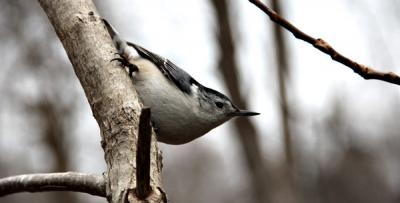Nature Notes: Christmas Bird Count

It was a frigid, blustery, sleety, snowy morning when the participants in the 84th Montauk Christmas Bird Count left the comfort of their homes on Dec. 14 to identify and count the birds in a 15-mile-diameter circle including Montauk, three quarters of Amagansett (including Napeague), Springs, and Gardiner’s Island. Some of the counters were participating in their 30th or more Montauk count. These Christmas counts were an alternative to hunting birds with guns and began in the very first years of the 20th century in New York City. This was the 114th consecutive year of such counts, which occur every year at this time throughout the entire United States, parts of Canada, Mexico, Central America, and parts of South America, as well as venues outside of the Western Hemisphere.
Angus Wilson, a physician based in New York, Karen Rubinstein, and Peter Polshek were this year’s count leaders, or “compilers.” A whopping 46,608 birds belonging to 110 different species were recorded from before dawn to well after sunset. A new species for the count, the Ross’s goose, was observed on the Montauk Downs golf course. The 110 species recorded closely matched the average for the last six years of 110.5 and were a pretty good number for such a foul-weathered day.
There were 31 counters this time around. The youngest was Hannah Mirando of Montauk, who went with her father, Michael, and Vicki Bustamante to record the birds east of Lake Montauk all the way to Montauk Point. She and her father saw the only Virginia rail on the count and her sharp eyes picked out two great blue herons. Hannah started studying birds when she was but 5 years old. Last spring she reported a painted bunting at her feeder, a very rare record for Long Island.
Other unusual birds for this time of year were a great egret, greater yellowlegs, and Wilson’s snipe. While there were no crossbills, evening grosbeaks, pine siskins, or other northern birds seen, there was a record number of snowy owl spread across the count area — 11! Five of them were counted on Gardiner’s Island including one that had snatched a duck. (See The Star’s front-page story.) There was also a northern shrike spotted in Napeague, one of the two American species of “butcher birds,” so called for catching mice and suspending them on thorns, then eating them.
Three bald eagles were tallied on Gardiner’s Island by the Rubenstein sisters and Mary Laura Lamont. It is the fifth count in a row during which Mary Laura has found a pair of bald eagles on Gardiner’s Island and further proof that at least one pair has begun breeding there. It should be noted that the last pair of bald eagles to breed in the Long Island area did so on Gardiner’s Island in 1936. One can’t help but wonder if the new ones are somehow related to that pair, but I strongly doubt that the earlier pair left any DNA around with which to make a comparison.
Among the other raptors recorded were three rough-legged hawks and a Cooper’s hawk. In this millennium, the Cooper’s hawk has begun breeding in various parts of Long Island after a longish absence. The rough-legged hawks breed well north of here. Ed Johan had a merlin (or pigeon hawk) land on a telephone pole on East Lake Drive in Montauk.
Only one species of alcid, or auk, was found, but in goodly numbers — 55 — off Montauk. Waterfowl were plentiful. There was perhaps a record number of scoters, 30,160 of them and all three species. There was also a large number of common eiders — 1,725 — yet not a single king eider. Ducks are quite colorful, and one of the prettiest, a harlequin duck, turned up in the waters north of Montauk west of the Point.
There was a shortage of songbirds and woodland birds. The Vicki Bustamante party had a hermit thrush and three cedar waxwings, very few sparrows, and no yellow-rumped warblers, generally a staple at this time of year. However, the record 10 Ipswich sparrows, a very uncommon, pale-colored bird, counted in 1999, was tied in the Dec. 14 count.
They breed on Sable Island in the Atlantic off northeastern Canada and like to stay in the beach grass on dunes, which best matches their coloring, while here in the winter. Snow buntings showed up on Gardiner’s Island but nowhere else.
One hundred and fourteen years of Christmas count records have proved to be very valuable in charting the ups and downs of this and that species. In the first years of the count, a passenger pigeon or two was observed before becoming extinct a few years later. Let us hope that the counters across the continent in a world torn by eternal strife do not follow in the passenger pigeon’s steps. Hannah Mirando’s first-time-around participation is at least one indication that such an outcome is highly unlikely.
